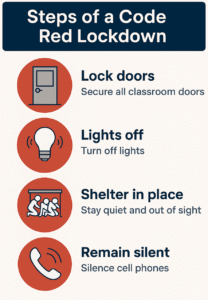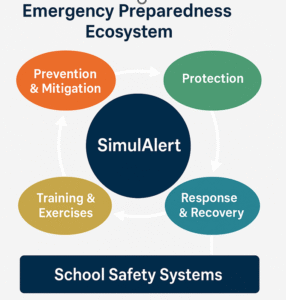News

Understanding Code Red: School Lockdown Protocols and Emergency Preparedness
In today’s climate, emergency preparedness for schools has become a top priority. With rising concerns around school safety, having effective school lockdown protocols is essential to protecting students, teachers, and staff during high-risk situations. Among these, the Code Red lockdown stands out as one of the most critical tools in a school’s safety plan. Although it may seem straightforward and easy to overlook, this procedure requires thoughtful implementation and serious attention to ensure its effectiveness in real-world scenarios. This blog explores the following:
- What is a Code Red Lockdown
- Why School Lock Down Protocols matter
- Key elements of Lock Down Procedures
- Foundation of preparedness
- Culture and community support
- Supporting mental health after a lockdown
What Is a Code Red Lockdown?
A Code Red lockdown is an emergency procedure activated when there is an immediate threat inside or near the school — such as an active shooter or an armed intruder.
When triggered, schools implement specific lockdown steps: doors are locked, lights are turned off, and students and staff remain silent and hidden in secure locations. The goal is to reduce visibility and exposure while awaiting law enforcement or emergency responders.
Why School Lockdown Protocols Matter
Effective school lockdown protocols can mean the difference between chaos and control. In moments of extreme stress, having a clearly defined, rehearsed plan saves valuable time and reduces panic.
More than just a checklist, a strong lockdown protocol creates a structured environment that builds confidence among staff and students. Regular drills transform fear into readiness, helping school communities feel empowered rather than helpless.
Key Elements of Lockdown Procedures
Robust lockdown protocols generally include:
- Rapid Alerts: An emergency alert system that notifies everyone quickly—via wearable badges, Visual displays, PA systems, mobile apps, or automated messages.
- Securing Spaces: Doors are locked, windows covered, lights turned off, and everyone shelters out of sight.
- Clear Communication: Ongoing updates and coordination with law enforcement throughout the incident.
- Post-Incident Support: Accounting for all individuals and offering counseling or medical attention if needed.
These elements form the backbone of emergency preparedness for schools and should be reviewed and refined regularly.

Figure 1 : Typical school lockdown steps
Training and Drills: The Foundation of Preparedness
Lockdown drills are not optional — they are a foundational part of any school’s safety culture. Schools conduct multiple Code Red drills each year to ensure everyone knows their role and reacts calmly.
Staff are also trained on communication protocols, first aid, and how to maintain order under pressure. Working with local law enforcement during drills reinforces realistic response strategies and helps identify vulnerabilities in real time.
Building a Culture of Preparedness and Community Support
Emergency preparedness for schools must involve more than administrators and teachers. Students, parents, custodians, security staff, and even local organizations all play critical roles in keeping schools safe.
Parents should be informed about lockdown procedures, while students should be encouraged to report suspicious activity. Community partnerships enhance vigilance, provide resources, and help create a culture of shared responsibility and safety.
Supporting Mental Health After a Lockdown
Whether real or a drill, lockdowns can be stressful and traumatic. That’s why schools must offer mental health support following any Code Red situation.
Counselors, support groups, and regular check-ins help students and staff recover emotionally and return to a sense of normalcy. A strong recovery plan is just as important as the response itself.
Conclusion: Lockdowns Are About Readiness, Not Fear
Understanding and implementing strong school lockdown protocols is essential for protecting lives. By combining preparation, communication, and community support, schools can create safer environments where students can focus on learning — not fear.
In the end, emergency preparedness for schools is not just a policy — it’s a commitment. With the right protocols in place, schools can be ready for anything.

Figure 2: Comprehensive Emergency Preparedness Ecosystem” and how SimulAlert integrates into the big picture
SimulAlert® enhances emergency response effectiveness by transforming how schools detect, communicate, and act during critical incidents. SimulAlert® doesn’t just send alerts—it orchestrates a full-spectrum response that’s fast, informed, and collaborative
Ready to take the next step in school security?
Click here to schedule a SimulAlert® demo.
Simple checklist
[ ] Conduct regular Code Red drills each semester
[ ] Train staff in emergency protocols and first aid
[ ] Establish a rapid alert communication system
[ ] Secure all classrooms and common areas
[ ] Partner with local law enforcement for realistic drills
[ ] Provide post-incident mental health support
[ ] Keep parents informed and engaged in safety plans



